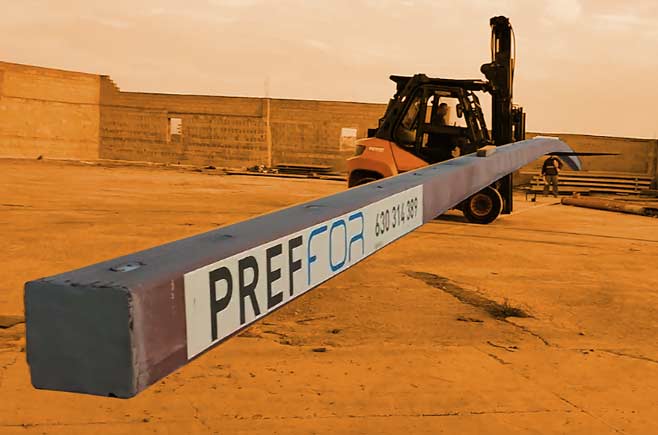The first time I heard about UHPC was in 2008. I had an informal meeting with Professor Pedro Serna, and I agreed with him to begin a research in this topic to perform my Final Degree Project. I started to read about it with a lot of interest, using mostly the Proceedings of the International Symposiums on UHPC, which took place in Kassel.
I remember that it seemed to me an outstanding material (it is). I had many ideas, most of them naïve, to use it everywhere. Now, more than a decade later, I know that there are applications where the use of UHPC is very competitive, but they are very specific. Savings in weight, maintenance or transport, among others, need to compensate the high cost of the material per cubic meter. Thus, the lower the cost per cubic meter, the higher the number of applications where it is reasonable to use the material. In this text I would like to mention some of the factors that I consider relevant to understand when UHPC is economically competitive:
Relevance of the UHPC cost in a structure:
If we determine the ratio between the cost of the UHPC of a structure and its total production cost, the value is highly variable. It can range between 15% in singular elements with complex formworks, to more than 50% in simple pieces that are repetitive. Obviously, it is in the last where the competitiveness of the piece is more sensitive to the cost of the material. Therefore, in these cases it is especially worth to work on obtaining or finding an affordable UHPC.
As an example, if you wish to decorate your home with a small UHPC furniture, you may invest time and efforts in doing a great design and an accurate mould. If you estimate these costs, possibly they are much higher than the cost of the small amount of UHPC premix you need to purchase (if there are not minimum order quantities). Thus, the cost per cubic meter is not a big issue for you.

Premix, or do-it-yourself?
Here I would like to use a comparison to start the explanation. If anyone asks you: how much costs to have dinner?, the immediate answer would be another question: “In a restaurant, or cooking at home?”. We know that the first is more expensive, but generally it has less risks and you have certain rights as a customer. If you cook by yourself, the best and the worst can happen, it depends on your abilities.
As in this example, purchasing a UHPC commercial premix is generally more expensive than doing it by yourself. The client receives the material with detailed instructions of the mixing time and process, even with the required curing conditions. The provider guarantees certain rheological and mechanical performance, which are aligned with the properties accepted by the main UHPC standards or Norms.
If the client decides to “cook at home”, he/she must consider several factors: It is needed to acquire available and suitable materials and optimize a UHPC mix with them. It may seem easy using any of the mix designs already published but changing a single component in a mix may modify both the rheological and mechanical properties. Optimizing a UHPC is a labyrinth with dozens of exits… and thousands of dead ends.
Adaptation to the structural requirements:
A UHPC premix has certain properties, and sometimes you do not need them all. In other words, you are wasting part of the value that you are paying for. When you have your own UHPC mix, you can adapt the mix design to the real needs of your product. If you do so, do not forget that the changes in a controlled mix may reduce your robustness, and you can lose the characteristic values that you needed to guarantee in your production.
Investment in your own UHPC.
As said before, doing structures or elements with your own UHPC seems more affordable, but we need to consider three main concepts:
- The investment done in the optimization: Obtaining a robust and affordable UHPC mix may require several months, and even few years of research and development. If you decide to invest in this research, do not forget to include this in your cost structure.
- The return on this investment: How many cubic meters of your self-developed UHPC will you use? The higher the volume, the lower the influence per cubic meter of your initial investment in the UHPC development.
- What is the cost of a failure or a delay? When you start a research, you must keep in mind that you don’t know when and how it is going to end. Maybe you cannot afford a six-months delay, or you provided a quotation of your finished UHPC product anticipating a development that now has proven to be impossible. Be realistic measuring these risks and be aware that they depend on your experience in the field.
Summarizing: If you want to use UHPC once or occasionally, possibly the best is that you purchase a premix, but if your idea is to integrate it in the production line probably the most economic at medium and long term is that you develop your own mix.
Where are you located?
As you may know, UHPC requires the use of selected raw materials, which do not exist in all the regions. The availability of fine silica sand, some pozzolanic additions or certain type of cements may seem obvious in some locations, but it is impossible in others. Thus, in certain countries you may need to make up with one of these three options:
- Pay a high price for a premix
- Develop an expensive UHPC by yourself, accepting that you need to import some of the selected materials because they are not available in the local market.
- Develop an affordable “poor” UHPC, accepting to use some raw materials that are not as selected as they should be. In this case, you will lose some performance, so you may need to redesign your elements.
As a conclusion, when you decide to use UHPC in a product or structure, there are some key questions that you need to ask yourself before starting:
How significant is the influence of the material costs over the total costs?
Use of a UHPC premix, or invest in developing your own UHPC?
What are the costs, timing and risks of developing it?…
If you want to give us your opinion, please write a comment. We appreciate different points of view!






One Response
not to forget the lack of standardized construction rules, which can differ from country to another. the difference is also on the use you want to: eat yourself or offer to thirds? responsabilities/liability are not the same.
Comments are closed.